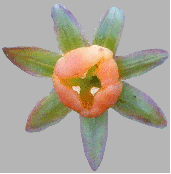|
Haemanthus
A review of the Haemanthus in the Eastern Cape will complete this brief
overview of East Cape Amaryllidaceae. At least five species of this fascinating genus with many varieties, occurring here. The most widespread is H. albiflos which is amazingly adaptive and versatile in its habitat. It is a particularly
desirable and easy to grow garden subject and is also suitable as a ground cover in areas of semi-shade. It is equally at home in deep shade on forest floors, on rocky sea shores exposed to salt spray, in coastal dune forest, on cliff faces in hot river valleys where it clings in large clumps to crevasses in full sun, and in shady places on high altitude inland mountain ranges. It is
evergreen and multiplies vegetatively, as well as from seed. The attractive white flowers appear in May and the ripe seeds are carried in equally attractive clusters of scarlet fruit. An interesting dwarf form with oval leaves occurs as single individual plants on bush clad hillsides in the Keiskama River valley.
Haemanthus montanus and H. humilis are much more localised in their
distribution. H. montanus prefers small areas of poorly drained shallow soil with an impervious substratum. It completes its annual cycle in four months, the period during which its fairly hostile habitat remains moist. It occurs in dense stands, the large cream flowers appearing in early January, rapidly
followed by two or three upright leaves. The seed ripens by mid February and germinates rapidly around the parent plants. The leaves dry off and blow away by the end of May when all signs of the bulb population have vanished. It adapts well to gardens and containers, and despite its long dormancy, is an
attractive subject. H. humilis humilis has fairly round flat leaves and occurs in isolated colonies on steep slopes between protective rocks. It is extremely variable with regard to size, the degree of hairiness and the colour of leaves and flowers. For instance a colony in the Kei River Valley growing under
acacia trees in semi shade have small grey hairy leaves and cream flowers, while another colony, growing in full shade on a south facing cliff less than 10km distant, has massive dark green leaves as large as dinner plates, almost hairless, and gorgeous large deep pink flowers. The rare H. carneus is very closely related to H. humilis, the differences being a rather looser, widely spreading umbel and stamens included well within the perianth, the only known Haemanthus with this feature. It occurs in grassland on the Bosberg mountain near Somerset East.
Alas, the future of the floral riches of the Eastern Cape is bleak many factors have led to the rapid degradation of the pristine ecosystems described by early travellers and botanist who visited this region a century and more ago.
Commercial farming, overgrazing by domestic cattle, sheep and goats,
particularly on communal land, commercial afforestation and the introduction of alien vegetation have all contributed to a rapid decline. The ever-increasing harvesting of wild medicinal bulbs by traditional healers has now become gross over-exploitation for commercial purposes.
However, small areas have remained protected. For instance, the road and railway reserves throughout the province are areas where some bulbs still
survive. Small areas of natural vegetation within fences erected around arable croplands still preserve certain species and limited areas inaccessible to both man and domestic animals do still exist. Sadly even in these preserved areas, recent developments of a socio-political nature have led to dramatic declines in plant populations, and many rare species may become extinct. Measures to improve the conservation and status of threatened populations are imperative, but in the current socio-political climate, are unlikely to be put in place. It is therefore important that the most threatened species be identified, grown and multiplied in cultivation to preserve bio-diversity before they are lost forever.
References:
Dold, T & Weeks, D. 2000. Nerine huttoniae, a rare Eastern Cape endemic,
Veld & Flora Vol.86 (1) 14 - 15, Botanical Society of South Africa.
Dyer, R.A., 1939. A Review of the Genus Cyrtanthus. Herbertia 6: 65 - 103
Reid. C. & Dyer, R.A. 1984. A review of Southern African species of Cyrtanthus, American Plant Life Society.
BACK SITE MAP
|
|



